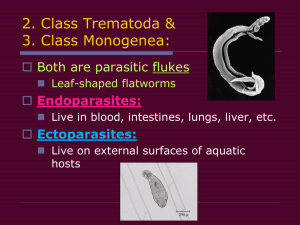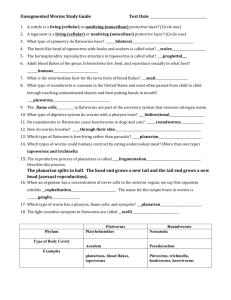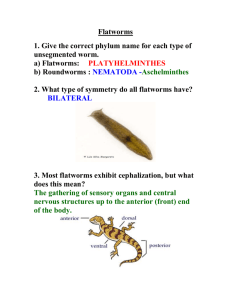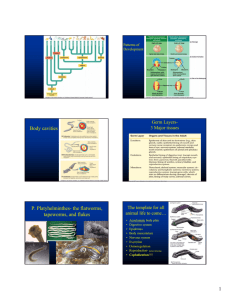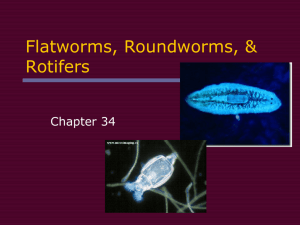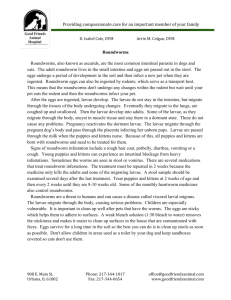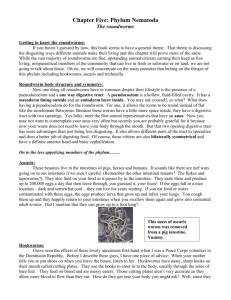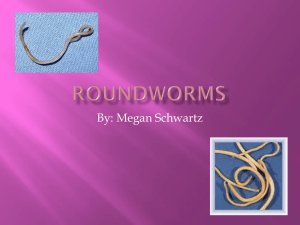Chapter 36-Flatworms, Roundworms, and Rotifers
advertisement
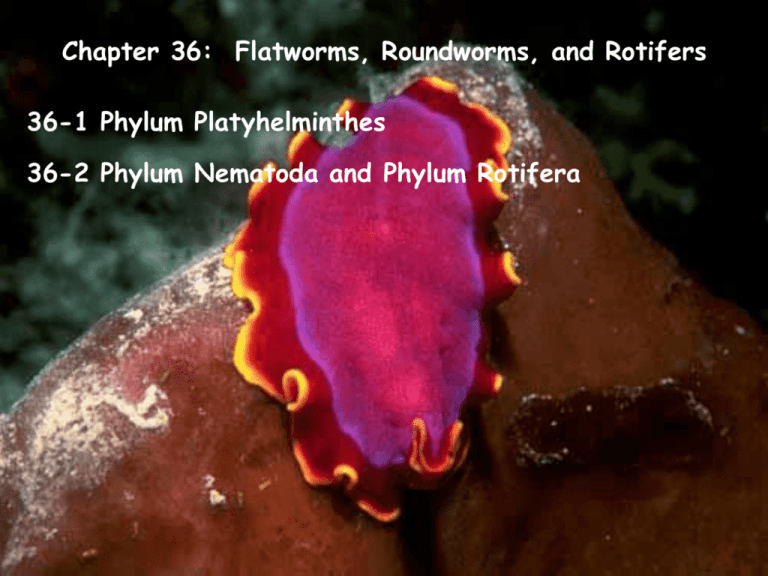
Chapter 36: Flatworms, Roundworms, and Rotifers 36-1 Phylum Platyhelminthes 36-2 Phylum Nematoda and Phylum Rotifera 36-1 Phylum Platyhelminthes I. Structure and Function of Flatworms (18,000 species) • BILATERAL symmetry, 3 GERM layers, ACOELOMATES, 1st ~ CEPHALIZATION, either FREE-living (complex) or PARASITIC (simpler). II. Class Turbellaria (4,500 species, largely aquatic) • FREE-living, freshwater PLANARIA glide through water in a wavelike motion. (A) Digestion and Excretion in Planarians • FEED by scavenging OR preying upon smaller protozoa. (1) Pharynx • Muscular TUBE draws in FOOD to gastrovascular cavity (NOT a gut). (2) Flame Cells (planarians coping with osmosis) • Collect EXCESS water and EXCRETE it through PORES in body’s surface. (B) Neural Control in Planarians (MORE complex than a NERVE NET) • Sensory cells are CONCENTRATED at HEAD region of body. (1) Cerebral Ganglia (TWO clusters of nerve cells; PRIMITIVE brain) • Receive INFO from sensory cells AND transmit signals to MUSCLES. (2) Eyespots (cup-shaped PHOTOSENSORY cells) • Behind ganglia, detect INTENSITY and DIRECTION of a LIGHT source. (C) Reproduction in Planarians (HERMAPHRODITIC, motile, free-living) • Simultaneous fertilization with EGGS laid in protective capsules (i.e., sexual reproduction) Critical Thinking (1) When would asexual reproduction be advantageous to a free-living flatworm? (1) Fission • Planarian SPLITS into two regeneration INTO 2 COMPLETE planaria. III. Class Trematoda (9,000 species of FLUKES) • Flatworms either endoparasite OR ectoparasite with a HOST. (1) Flukes (all species ~ PARASITIC) • Cling to HOST w/ SUCKER, drawing BODY FLUIDS into gastrovascular cavity. (A) Structure of Flukes • Similar to planarians, but LACK eyespots AND protected by a specialized TEGUMENT. (1) Tegument (continuous sheet of FUSED cells of flukes) • Outer GLYCOPROTEIN layer protects against HOST white blood cells AND digestive enzymes. (B) Reproduction and Life Cycle of Flukes • Hermaphroditic ~ LIFE CYCLES use primary AND intermediate hosts (e.g., Schistosomes—blood flukes of separate sexes) (1) Uterus • Long, coiled tube stores up to 10,000 eggs at a time (to be released). (2) Primary Host (e.g., Human blood vessels for adult schistosomes) • Where ADULT gets nourishment AND develops into a sexually mature adult fluke (site of reproduction). (3) Intermediate Host (e.g., Aquatic snails for juvenile larvae) • Where LARVA gets nourishment AND develops a tail for swimming to INVADE primary host. (4) Schistosomiasis (~ Schistosoma: Asia, Africa, and South America) • EGGS in body are carried by blood where they BLOCK blood vessels and cause irritation, bleeding, and tissue decay. (NOTE: And sometimes death, BAD for a parasite). Critical Thinking (2) The Aswan High Dam across the Nile River in Egypt was completed in 1970. The dam was built to increase the supply of irrigation water, control major flooding, and provide a source of hydroelectric power. Since the dam was built, however, there has been an increase in the incidence of schistosomiasis in the region. Why would this be likely? (5) Swimmer’s Itch (North America) • Small brown FRESHWATER flukes, results in skin irritation and swelling. IV. Class Cestoda (5,000 species of tapeworms) • Tapeworms enter HOST when raw OR undercooked materials containing EGGS are consumed (e.g., beef, fish, pork) (1) Tapeworms (parasitize vertebrates) • Inhabit INTESTINES and absorb nutrients DIRECTLY through their skin. (A) Structure of Tapeworms (very specialized) • PROTECTED by a tegument BUT lack eyespots, a mouth, a gastrovascular cavity, AND digestive organs. (1) Scolex (attachment organ) • At anterior, covered with HOOKS / SUCKERS ~ attachment. (2) Proglottids (tapeworm body sections) • GROW by adding PROGLOTTIDS behind its scolex contain male AND female SEX organs. (B) Reproduction and Life Cycle of Tapeworms (primary host ~ human) (1) Eggs pass OUT in FECES, (2) Eggs are INGESTED into HOST, (3) Larvae hatches and ENCYSTS into host’s MUSCLE tissue, and (4) Cyst hatches into larvae when tissue is EATEN; TAPEWORM results. (1) Cysts • DORMANT larvae inside protective coat ENCYSTED in muscle tissue. 36-2 Phylum Nematoda and Phylum Rotifera I. Phylum Nematoda (80,000 species of roundworms, 150 parasitic) • Pseudocoelomates, a DIGESTIVE tract with 2 openings, MOST species have SEPARATE sexes. (1) Anus (and mouth are BOTH part of a digestive tract) • Unidirectional tract ALLOWS parts to become SPECIALIZED. ( i.e., for DIGESTION and ABSORPTION) (2) Cuticle • Protective layer COVERING similar to TEGUMENT. (A) Ascaris (a genus of intestinal roundworms, eggs hatch in INTESTINE) • EGGS enter body through contaminated FOOD or WATER. (B) Hookworms (travel through blood to the THROAT, then swallowed) • Feed on host INTESTINAL blood with cutting MOUTH PLATES, results in ANEMIA (eggs hatch in WARM, DAMP SOIL). Critical Thinking (3) Hookworm infections are very common in China, where rice is grown in paddies that are periodically flooded. Considering what you know about hookworm invasion, why do you suppose hookworm infections are this common in China? (C) Trichinella (genus of parasitic roundworms) • Embed in HOST intestine, results in LARVAE travel through BLOOD to embed CYSTS in MUSCLE. (1) Trichinosis (uncooked pork) • Disease from ENCYSTED trichinella, causes muscle PAIN, stiffness, and sometimes death (encysted HEART muscle). (D) Other Parasitic Roundworms • PINWORMS and FILARIAL worm infections (also nematodes). (1) Pinworm (Enterobius) • White-thread worms live AND mate in LOWER intestine, coming out at NIGHT to lay eggs on surface of anus. (scratch AND transport reflex) (2) Filarial Worms (e.g., Elephantiasis, requires MOSQUITO carrier) • Larvae injected AFTER a BITE develop into ADULTS in lymphatic system, BLOCKING circulation AND causing FLUID to accumulate in limbs. (3) Elephantiasis • SEVERE case of filarial worm BLOCKAGE where limbs become extremely swollen DUE TO LYMPHATIC FLUID. (4) Heartworm Disease • Filarial worm infection lives in HEART and ARTERIES of LUNGS of dogs. II. Phylum Rotifera (1,750 species) • Pseudocoelomates, transparent, FREE-living AND cephalized; use a CROWN of CILIA surrounding mouth for feeding. (1) Mastax • Muscular organ BREAKS food into smaller pieces SENT to STOMACH and then INTESTINE. (2) Cloaca (works with FLAME cells AND excretory tubules) • Chamber SHARED by digestive, reproductive, AND excretory systems. (expels water, wastes, and eggs from anus) Extra Slides AND Answers for Critical Thinking Questions (1) Asexual reproduction would be advantageous whenever the flatworm has little likelihood of finding and mating with another individual of the same species. (2) The lake behind the dam and the many new irrigation canals provide favorable habitats for snails, which serve as intermediate hosts to schistosomes. (3) Hookworm eggs hatch in warm, damp soil, such as that found in and around rice paddies. Because the field workers often go barefoot, they are more likely to become infected with hookworm larvae, which enter their hosts by boring through the feet.
